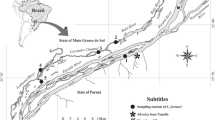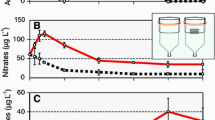Abstract
Limnoperna fortunei (Bivalvia, Mytilidae), a freshwater bivalve native to Southern Asia, has been an invasive species in South America since 1991. It spread upstream in the La Plata basin reaching the Paraguay River in the vicinity of the Pantanal wetland, Brazil, around 1998. The role of abiotic factors in controlling establishment and abundance of this species is not well known, making projections of its risk of further spread difficult. This study evaluates the importance of abiotic factors to L. fortunei populations established in rivers of the Pantanal, focusing on larval and juvenile densities and taking advantage of a wide range of seasonal variability in water temperature, flow, dissolved oxygen, and suspended material. Temperature, river stage (influencing several water characteristics) and water velocity are the main variables related to the larval and juvenile densities. In the Pantanal, environmental variables vary over a broader range compared with other South American locations, subjecting L. fortunei to oxygen depletion, low calcium, low pH, and high water velocity and suspended solids, associated with low chlorophyll a concentrations. The combined effect of several of these conditions may explain the relatively low densities in some Pantanal sites. However, they probably will not prevent the persistence of populations in the Pantanal and the eventual establishment of viable populations in upriver systems connected to the Pantanal. These results are pertinent not only to this species but also to other aquatic invasive invertebrates whose expansion may be limited by thermal extremes, episodic oxygen depletion, and waters that are too dilute or acidic for optimal biocalcification.






Similar content being viewed by others
References
Allen YC, Thompson BA, Ramcharan CW (1999) Growth and mortality rates of the zebra mussel, Dreissena polymorpha, in the lower Mississippi River. Can J Fish Aquat Sci 56:748–759
APHA (1998) Standard methods for the examination of water and wastewater, 20th edn. American Public Health Association, American Water Works Association, and Water Environment Federation, Washington, DC, 1268 p
Baines SB, Fisher NS, Cole JJ (2005) Uptake of dissolved organic matter (DOM) and its importance to metabolic requirements of the zebra mussel, Dreissena polymorpha. Limmnol Oceanogr 50:36–47
Baines SB, Fisher NS, Cole JJ (2007) Dissolved organic matter and persistence of the invasive zebra mussel (Dreissena polymorpha) under low food conditions. Limnol Oceanogr 52:70–78
Boltovskoy D, Cataldo D (1999) Population dynamics of Limnoperna fortunei, an invasive fouling mollusc, in the Lower Paraná River (Argentina). Biofouling 14:255–263
Boltovskoy D, Sylvester F, Otaegui A et al (2009). Environmental modulation of reproductive activity of the invasive mussel Limnoperna fortunei: implications for antifouling strategies. Austral Ecol. doi:10.1111/j.1442-9993.2009.01974.x
Bossenbroek JM, Johnson LE, Peters B et al (2007) Forecasting the expansion of Zebra Mussels in the United States. Conserv Biol 21(3):800–810
Calheiros DF, Hamilton SK (1998) Limnological conditions associated with natural fish kills in the Pantanal Wetland of Brazil. Verh Internat Verein Limnol 26:2189–2193
Cataldo D, Boltovskoy D, Hermosa JL et al (2005) Temperature-dependent rates of larval development in Limnoperna fortunei (Bivalvia:Mytilidae). J Moll Stud 71:41–46
Darrigran G, Penchaszadeh P, Damborenea MC (1999) The reproductive cycle of Limnoperna fortunei (Dunker, 1857) (Mytilidae) from a neotropical temperate locality. J Shellfish Res 18(2):361–365
Darrigran G, Damborenea MC, Penchaszadeh P et al (2003) Reproductive stabilization of Limnoperna fortunei (Bivalvia Mytilidae) after ten years of invasion in the Americas. J Shellfish Res 22:141–146
Deaton LE, Derby JGS, Subhedar N et al (1989) Osmorregulation and salinity tolerance in two species of bivalve mollusk: Limnoperna fortunei and Mytilopsis leucophaeta. J Exp Mar Biol Ecol 133:67–79
Depretris PJ, Kempe S (1993) Carbon dynamics and sources in the Paraná River. Limnol Oceanogr 38:382–395
dos Santos CP, Wurdig NL, Mansur MCD (2005) Fases larvais do mexilhão dourado Limnoperna fortunei (Dunker) (Mollusca, Bivalvia, Mytilidae) na Bacia do Guaíba, Rio Grande do Sul, Brasil. Rev Bras Zool 22:702–708
Drake JM, Bossenbroek JM (2004) The potential distribution of Zebra Mussels in the United States. Bioscience 54(10):931–941
Gran G (1952) Determination of the equivalence point in potentiometer titrations, Part II. Analyst 77:661–671
Guo Q (2006) Intercontinental biotic invasions: what can we learn from native populations and habitats? Biol Invasions 8:1451–1459
Hamilton SK, Sippel SJ, Melack JM (1995) Oxygen depletion and carbon dioxide and methane production in waters of the Pantanal wetland of Brazil. Biogeochemistry 30:115–141
Hamilton SK, Sippel SJ, Calheiros DF et al (1997) An oxygen depletion event and other biogeochemical effects of the Pantanal wetland on the Paraguay River. Limnol Oceanogr 42:257–272
Ho KC, Chow YL, Yau JTS (2003) Chemical and microbiological qualities of the East River (Dongjiang) water, with particular reference to drinking water supply in Hong Kong. Chemosphere 52:1441–1450
Iwasaki K, Uryu Y (1998) Life cycle of a freshwater mytilid mussel, Limnoperna fortunei, in Uji River, Kyoto. Jpn J Malacol 57(2):105–113
Karatayev AY, Boltovskoy D, Padilla D et al (2007) The invasive bivalves Dreissena polimorpha and Limnoperna fortunei: parallels, contrasts, potential spread and invasion impacts. J Shellfish Res 26:205–213
Kempe S (1982) Long-term records of CO2 pressure fluctuations in fresh waters. SCOPE/UNEP Sonderband 52:91–332
Kluza DA, McNyset M (2005) Ecological niche modeling of aquatic invasive species. Aquat Invaders 16(1):1–7
Lee SY, Morton B (1983) The Hong Kong Mytilidae. In: Morton B, Dudgeon D (eds) The malacofauna of Hong Kong and Southern China II. Proceedings of the second international workshop on the malacofauna of Hong Kong and Southern China. Hong Kong University Press. Hong Kong, pp 49–76
Madon SP, Schneider DW, Stoeckel JA et al (1998) Effects of inorganic sediment and food concentrations on energetic processes of the zebra mussel, Dreissena polymorpha: implications of growth in turbid rivers. Can J Fish Aquat Sci 55:401–413
Magara Y, Matsui Y, Goto Y et al (2001) Invasion of the non indigenous nuisance mussel, Limnoperna fortunei, into water supply facilities in Japan. J Water Supply Res Technol - AQUA 50:113–124
Marker AFH, Nush EA, Rai H et al (1981) The measurement of photosynthetic pigments in freshwaters and standardization of methods: Conclusions and recommendations. Arch Hydrobiol Beih Ergebn Limnol 14:91–106
Montalto L, Marchese M (2003) Limnoperna fortunei (Dunker, 1857) (Bivalvia:Mytilidae) tolerance to temperature and pH in experimental conditions. Neotropica 49:26–34
Morton B (1975) The colonization of Hong Kong’s water supply system by Limnoperna fortunei (Dunker 1857) (Bivalvia: Mytilacea) from China. Mal Rev 8:91–105
Morton B (1977) The population dynamics of Limnoperna fortunei (Dunker 1857) (Bivalvia: Mytilacea) in Plover Cove reservoir, Hong Kong. Malacologia 16:165–182
Morton B (1982) The reproductive cycle in Limnoperna fortunei (Dunker 1857) (Bivalvia: Mytilidae) fouling Hong Kong’s raw water supply system. Oceanol Limnol Sinica 13:312–325
Morton B (1987) Comparative life history tactics and sexual strategies of the fresh and brackish water bivalve fauna of Hong Kong and Southern China. Am Malacol Bull 5:91–99
Morton B (1996) The aquatic nuisance species problem: a global perspective and review. In: D’Itri FM (ed) Zebra mussels and other aquatic nuisance species. Ann Arbor Press, Chelsea, pp 1–54
Nagaya K, Matsui Y, Ohira H et al (2001) Attachment strength of an adhesive nuisance mussel, Limnoperna fortunei, against water flow. Biofouling 17:263–274
Oliveira MD (2009) Factors controlling the density and potential distribution of golden mussel (Limnoperna fortunei Dunker 1857) in the Upper Paraguay Basin. Ph.D. thesis, Universidade Federal de Minas Gerais, Belo Horizonte, Brazil
Oliveira MD, Calheiros DF (2000) Flood pulse influence on a phytoplankton community in south Pantanal floodplain, Brazil. Hydrobiologia 427:101–112
Oliveira MD, Hamilton SK, Jacobi CM (2010a) Forecasting the expansion of the invasive golden mussel Limnoperna fortunei in Brazilian and North American rivers based on its occurrence in the Paraguay River and Pantanal wetland of Brazil. Aquat Invasions 5(1):59–73
Oliveira MD, Hamilton SK, Calheiros DF, Jacobi CM (2010b) Oxygen depletion events control the invasive golden mussel (Limnoperna fortunei) in a tropical floodplain. Wetlands 30(4):705–716. doi:10.1007/s13157-010-0081-3
Oliveira MD, Takeda AM, Barros LF et al (2006) Invasion by Limnoperna fortunei (Dunker, 1857) (Bivalvia Mytilidae) of the Pantanal wetland, Brazil. Biol Invasions 8:97–104
Pastorino G, Darrigran G, Martin SM et al (1993) Limnoperna fortunei (Dunker, 1857) (Mytilidae), nuevo bivalvo invasor en aguas del Rio de La Plata. Neotropica 39:34
PCBAP (Plano de Conservação da Bacia do Alto Paraguai) (1997) Análise Integrada e prognóstico da Bacia do alto Paraguai.Programa Nacional do Meio Ambiente. Brasília: PNMA. V.3. 367 p
Peterson AT, Vieglais DA (2001) Predicting species invasions using ecological niche modeling: new approaches from bioinformatics attack a pressing problem. Bioscience 51:363–371
Ricciardi A (1998) Global range expansion of the Asian mussel Limnoperna fortunei (Mytilidae): another fouling threat to freshwater systems. Biofouling 13:97–106
Schneider DW, Madon SP, Stoeckel JA et al (1998) Seston quality controls zebra mussel (Dreissena polymorpha) energetics in turbid rivers. Oecologia 117:331–341
Silva DP (2006) Aspectos bioecológicos do mexilhão dourado Limnoperna fortunei (Bivalvia, Mytilidae) (Dunker, 1857). Ph.D. thesis. Universidade Federal do Paraná. Curitiba, 138 p
Wang HZ, Xie Z, Wu XP et al (1999) A preliminary study of zoobenthos in the Poyang Lake, the largest freshwater lake of China, and its adjoining reaches of Changjiang River. Acta Hydrobiol Sinica 23:132–138
Wang HZ, Xu QQ, Cui YD et al (2007) Macrozoobenthic community of Poyang Lake, the largest freshwater lake of China, in the Yangtze floodplain. Limnology 8:65–71
Wetzel RA, Likens GE (2001) Limnological analyses. Springer, New York 391 p
Wilkinson L (2004) Systat 11. SYSTAT Software Inc, San José
Xie Z, Liang YL, Wang J et al (1999) Preliminary studies of macroinvertebrates of the Mainstream of the Changjiang (Yangtze) River. Acta Hydrobiol Sinica 23:148–157
Zhang SR, Lu XX, Higgitt DL et al (2007) Water chemistry of the Zhujiang (Pearl River): natural processes and anthropogenic influences. J Geophys Res Earth Surf 112:1–17
Acknowledgments
This work was supported by The National Council for Scientific and Technological Development (PELD and CTHIDRO programs), and Embrapa Pantanal. We are grateful to the Pantanal Matogrossense National Park for the field assistance, and the Federal University of Minas Gerais/ECMVS and US Fish and Wildlife Service for support. We are also grateful to Maria D. Oliveira, Egidia do Amaral, Waldomiro L. Silva, and Isac Teixeira for technical assistance, and to the students Viviane Eilers, Izabella Xavier, Claudiane Santos, and Tatiane Cielo for the great collaboration in field work and laboratory analyses. The valuable suggestions of two anonymous referees are gratefully acknowledged.
Author information
Authors and Affiliations
Corresponding author
Rights and permissions
About this article
Cite this article
Oliveira, M.D., Calheiros, D.F., Jacobi, C.M. et al. Abiotic factors controlling the establishment and abundance of the invasive golden mussel Limnoperna fortunei . Biol Invasions 13, 717–729 (2011). https://doi.org/10.1007/s10530-010-9862-0
Received:
Accepted:
Published:
Issue Date:
DOI: https://doi.org/10.1007/s10530-010-9862-0




